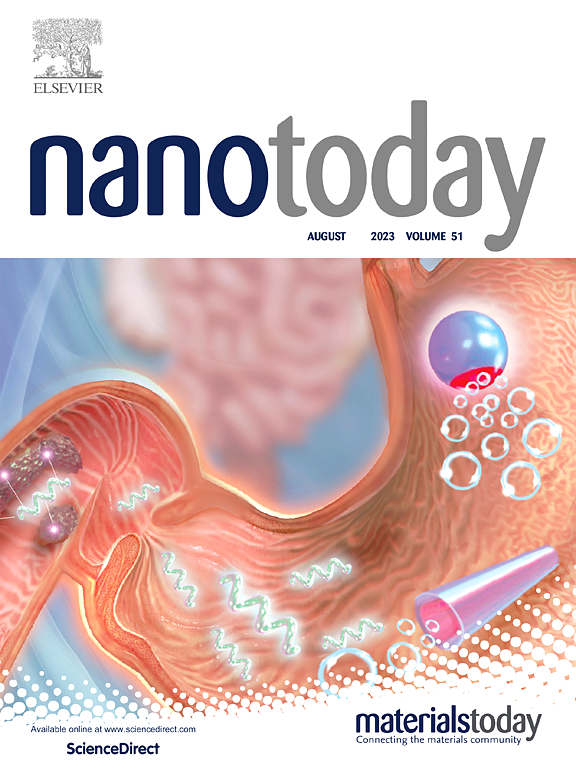Aquaporin encoding mRNA mediated water bomb vaccine for cancer immunotherapy
IF 10.9
1区 材料科学
Q1 CHEMISTRY, MULTIDISCIPLINARY
引用次数: 0
Abstract
Inducing immunogenic cell death (ICD) in tumors is a promising strategy for activating systemic antitumor immunity. However, most ICD approaches rely on chemotherapeutic or physical agents that pose challenges in controllability and biosafety. Here, we report a drug-free, mRNA-based strategy that induces a novel form of ICD via a “water bomb” effect. By delivering aquaporin mRNA into tumor cells using nucleic acid nanocarriers, aquaporins are expressed and embedded in the tumor cell membrane. Upon modulation of the transmembrane osmotic gradient, water influx is rapidly amplified through aquaporin channels, leading to extreme cellular swelling, complete membrane rupture, and explosive tumor cell lysis. This unique form of endogenously driven mechanical ICD elicits potent immune activation by concurrently releasing a full spectrum of damage-associated molecular patterns (DAMPs), tumor-specific antigens, and neoantigens in situ, thereby promoting efficient activation of bone marrow-derived dendritic cells (BMDCs) and enhancing subsequent antigen presentation. In a murine melanoma model, this strategy significantly inhibited the growth of both primary and distant tumors, as well as lung metastases. Similarly, in a breast cancer mouse model, it markedly suppressed the growth of subcutaneous tumors. With excellent biocompatibility, tunability, and immune potency, this “water bomb” based approach offers a conceptually new paradigm for cancer immunotherapy via endogenously driven mechanical ICD.
水通道蛋白编码mRNA介导的肿瘤免疫治疗水弹疫苗
在肿瘤中诱导免疫原性细胞死亡(ICD)是一种很有前途的激活全身抗肿瘤免疫的策略。然而,大多数ICD方法依赖于化疗或物理药物,这在可控性和生物安全性方面构成挑战。在这里,我们报告了一种无药物、基于mrna的策略,通过“水弹”效应诱导一种新型的ICD。利用核酸纳米载体将水通道蛋白mRNA传递到肿瘤细胞中,实现水通道蛋白在肿瘤细胞膜上的表达和包埋。在跨膜渗透梯度的调节下,水通过水通道蛋白通道流入迅速放大,导致细胞极端肿胀,膜完全破裂,肿瘤细胞爆发性溶解。这种独特的内源性驱动机械ICD通过同时释放全谱损伤相关分子模式(DAMPs)、肿瘤特异性抗原和原位新抗原,从而促进骨髓源性树突状细胞(bmdc)的有效激活,并增强随后的抗原呈递,从而引发有效的免疫激活。在小鼠黑色素瘤模型中,该策略显著抑制了原发肿瘤和远处肿瘤以及肺转移瘤的生长。同样,在乳腺癌小鼠模型中,它显著抑制了皮下肿瘤的生长。这种基于“水弹”的方法具有良好的生物相容性、可调性和免疫效力,为通过内源性驱动的机械ICD进行癌症免疫治疗提供了概念上的新范例。
本文章由计算机程序翻译,如有差异,请以英文原文为准。
求助全文
约1分钟内获得全文
求助全文
来源期刊

Nano Today
工程技术-材料科学:综合
CiteScore
21.50
自引率
3.40%
发文量
305
审稿时长
40 days
期刊介绍:
Nano Today is a journal dedicated to publishing influential and innovative work in the field of nanoscience and technology. It covers a wide range of subject areas including biomaterials, materials chemistry, materials science, chemistry, bioengineering, biochemistry, genetics and molecular biology, engineering, and nanotechnology. The journal considers articles that inform readers about the latest research, breakthroughs, and topical issues in these fields. It provides comprehensive coverage through a mixture of peer-reviewed articles, research news, and information on key developments. Nano Today is abstracted and indexed in Science Citation Index, Ei Compendex, Embase, Scopus, and INSPEC.
 求助内容:
求助内容: 应助结果提醒方式:
应助结果提醒方式:


